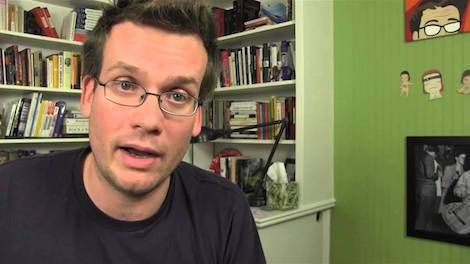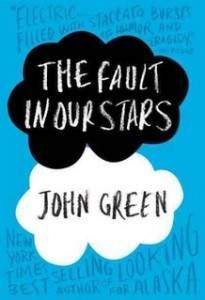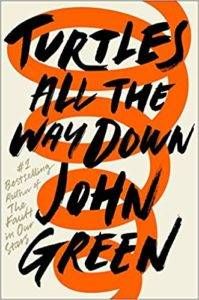
Reading John Green’s TURTLES ALL THE WAY DOWN as a Nerdfighter
I want to talk about John Green’s new book, Turtles All the Way Down, in which 16-year-old Aza Holmes tries to locate a fugitive billionaire while struggling with intrusive thought spirals caused by her Obsessive-Compulsive Disorder. But to do that, I first have to talk about his last book: The Fault in Our Stars.

The book transported me into the world of protagonists Hazel and Gus, but also through my first year of Nerdfighteria. As I read, I thought back to videos John had made over the previous year where he referenced ideas and places that ended up in the book.
In the book, Hazel remarks, “Sometimes, you read a book and it fills you with this weird evangelical zeal, and you become convinced that the shattered world will never be put back together unless and until all living humans read the book.” This is how I felt about TFiOS. I convinced my siblings, mom, and several friends to read it so we could discuss what it says about the complicated relationships humans have with each other and with our own desire for meaningful lives.
However, Hazel continues, “And then there are books . . . which you can’t tell people about, books so special and rare and yours that advertising your affection feels like betrayal.”

TAtWD feels “so special and rare and [mine]” because I’ve watched the Vlogbrothers channel religiously for the last seven years. I look up to the Green brothers as mentors, John especially because we’re both writers. In their many online projects, they promote the spread of empathy—whether they’re talking about thoughts from places or sharing the life stories of refugees. While this is not a two-way relationship, this mentorship has influenced my life; they’ve inspired me, a navel-gazing introvert, to spend more time looking outward and imagining others as complexly as I imagine myself.
I once wrote a paper for a literary research class that traced elements of an author’s book back to direct influences from their life. I chose J.M. Barrie’s Peter Pan and ended up with twenty pages; the more I delved into Barrie’s history, the more connections I discovered. While others in the class found that analyzing the context ruined the work for them, this made me love “my” book even more. Spending the last seven years as a Nerdfighter has meant that I essentially did the same research about TAtWD, only before I ever read the book.
Lots of things in TAtWD can be traced back to Vlogbrothers (albeit with a little retrospective re-watching for Easter eggs). Back in a January video, John mentions having a dream in which he was a tuatara, a reptile which plays a major role in the book. When asked, “Hey, are you writing another book?” in a 2015 “Question Tuesday” video, John shows off a Wookiee Gunship he’d built with his son instead of answering—a possible reference to Aza’s friend Daisy’s minor notoriety as an author of Star Wars’ Chewbacca fan fiction. In another 2015 video, he kayaks on Indianapolis’ White River, like Aza and Daisy do in chapter three.
In a 2015 video called “Let’s Go Outside,” John explains how Indianapolis was one of the largest cities formed around a non-navigable waterway, a story Daisy tells Aza while they’re kayaking. He also mentions how he likes “the irregularly shaped polygons that the sky forms around the trees.” Aza’s deceased father liked to take pictures of the same thing, and she often scrolls through these photos on his old cell phone, pondering his fixation.
The parallels continue: Aza and John both describe makeup as a kind of “armor” (94), have an unhealthy relationship with hand sanitizer, and have broken a rib. Oh, and they both suffer from Obsessive-Compulsive Disorder.
The most satisfying ideas to trace back were the larger themes John’s been ruminating on for years, his OCD central to them all. The first time I remember John mentioning his mental health was back in a 2013 video, but he went more in-depth with it as OCD in a 2015 video, saying he finds it hard to talk about, not because he’s ashamed, but because “the central way we imagine sickness as a thing that we must conquer and then put behind us doesn’t really apply to chronic illness.” Aza struggles with the same idea—she admits wanting to tell her therapist “I was getting better, because that was supposed to be the narrative of illness: It was a hurdle you jumped over, a battle you won” (85). Yet, this is not the case for her, and she tells her friends that her OCD is something that “doesn’t get better” (155).
Aza doesn’t know how to explain her intrusive thoughts to her friends. These unwelcome ideas hijack her consciousness in an all-encompassing, tightening spiral and tell her she’s going to die of a rare illness unless she performs ritual compulsions. John, too, has been trying to explain his own experiences with intrusive thoughts for years, but he’s said that both physical and psychic pain are “almost inexpressible,” that pain “doesn’t just defy language, it kind of destroys language.” Aza’s therapist echoes this, noting that we try to use metaphor and simile to describe pain, but it’s ultimately inadequate. This summer, John made an entire video about his OCD, in which he states, “I can say what it’s like more than I can say what it is,” a sentiment Aza repeats almost verbatim. Her consciousness is like a whirlpool, a demon, a prison.
TAtWD is as much about trying to find language for this pain as it is about the mystery of the fugitive billionaire. John and Aza continually return to the metaphor of the body and mind as a prison. John has said that “Pain is a reminder that you are alone inside your body, that no one else can access your consciousness, and that what you call your ‘self’ is at least in some ways a kind of prison from which there is no earthly escape.” He describes this existential sensation as “horror-movie-level terrifying,” which mirrors a conversation in which Aza tells Daisy what she’s afraid of: not the dark or the creepy crawly, but rather her inability to control her own thoughts, and by extension, this thing she calls her “self.” She describes being stuck in a thought spiral as being “stuck inside a prison cell that is exactly the size of you, until eventually you realize that you’re not actually in a prison cell. You are the prison cell” (150). John says this pain can “[turn him] inward in an ever-tightening spiral.”
Popular culture often depicts those with mental illness as having a secret advantage because of it; in the TV show Monk, the protagonist’s OCD makes him both a deeply troubled man and an incredible detective. TAtWD shows a different perspective on this narrative. John says in his video on OCD, “I don’t feel like my mental illness has any super power side effects. In fact, when I’m stuck inside a thought spiral, I find it very difficult to observe, like, anything outside of myself. I become a terrible detective.” Aza expresses a similar sentiment, remarking, “I was one of the least observant people I’d ever met” (133), which disrupts her attempts to find the fugitive billionaire and makes her less attentive to her friends.
These thoughts made their way into John’s book, but also into my life, with uncanny timing. A few years ago, a friend came to me and laid bare her soul describing her own intrusive thought spirals, worried she was crazy and that I might disbelieve her fear that she had OCD. I didn’t think she was crazy—it made perfect sense, because everything she said sounded familiar. It was as if I had been unknowingly prepared for this conversation and—I hope, at least—that everything I’d been learning made me a better friend that night and ever since. As John has said, “sometimes listening generously to people in pain and believing them can be very good medicine.”
When the book was finally released, I had been thoroughly prepared to enjoy it. The themes harmonized with what I had been internalizing; they were so distinctly John. The story itself was new, though, and rather than being drawn out of it when thinking back to Vlogbrothers videos, my foreknowledge drew me deeper into Aza’s story. A few times, the content felt redundant, but I wasn’t sure if it was because John was repeating himself or rephrasing something he once said online, or if he was echoing something similar I had once thought myself.
John says that writing is one thing that can pull him out of “the prison of [his] consciousness” for a while, and reading does the same for me. Aza’s story took me out of myself; I felt connected to her character, not because I suffer from OCD, but because her narration brought me into her life, into her pain, for a few hours. Because of that, I understand both John and my friend a little better. In an article for The New York Times, Hank is quoted as having a similar experience: “Even having a brother who deals with OCD, I never really got it until I read the book.” Literature has the power to help us bridge the empathy gap and meet each other halfway.
John said on Reddit recently that he’s not sure if he’ll write another book. I hope he does, but if not, I’ll keep following him down all the internet rabbit trails where he shares his thoughts, because, as Hazel once told her favorite author, “Frankly, I’d read your grocery lists.” John, reading TAtWD after following your online self for the last seven years made me feel “something we don’t have a word for” (58), so I had to write this article to explain it. Thank you for this gift.








